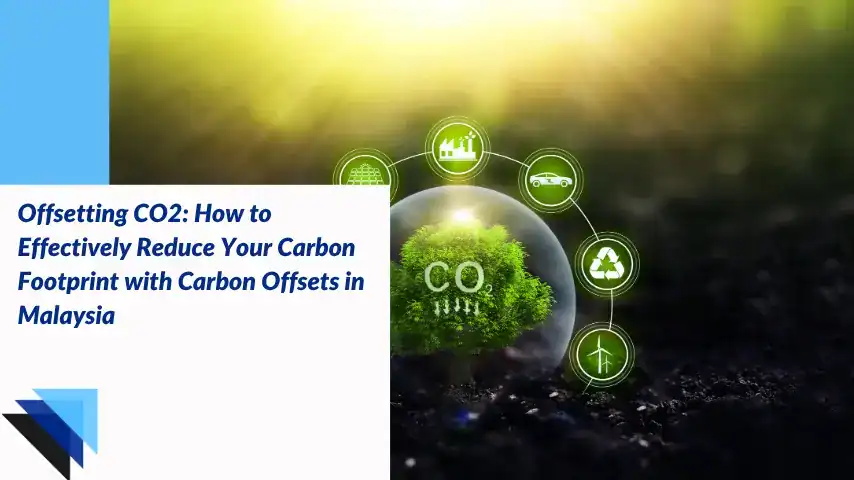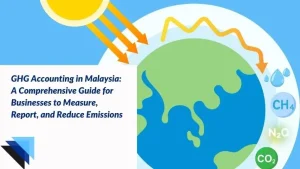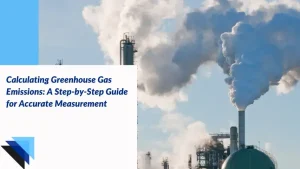Carbon offsetting in Malaysia involves investing in projects that reduce or remove greenhouse gas emissions to compensate for your carbon footprint. From renewable energy initiatives to forest conservation efforts, these programs offer practical solutions for both individuals and businesses committed to environmental responsibility.
In this comprehensive guide, we’ll explore:
- How carbon offsetting works in the Malaysian context
- Various types of offset projects available locally
- Step-by-step implementation strategies
- Verification processes and best practices
- Cost-effective ways to reduce your carbon footprint
Whether you’re an eco-conscious individual or a business leader, discover how to make a real difference in Malaysia’s fight against climate change through verified carbon offset programs.
Wondering How to Implement Carbon Offsetting for Your Business?
Take the first step towards sustainability by integrating effective carbon offsetting strategies that align with international standards.
- What Is Carbon Offsetting and Why Is It Important in Malaysia?
- What Are the Types of Carbon Offset Projects in Malaysia?
- What Is the Difference Between Carbon Removal and Carbon Reduction?
- Why Are Verification and Quality Standards Crucial for Carbon Offsetting Projects?
- What Are Carbon Offsetting Strategies and How Are They Implemented?
- What Is Impact Assessment and How Does It Relate to Carbon Offsetting?
- What Does the Future of Carbon Offsetting in Malaysia Look Like?
- How Wellkinetics Can Help
What Is Carbon Offsetting and Why Is It Important in Malaysia?
Carbon offsetting has emerged as a crucial strategy in Malaysia’s fight against climate change, offering individuals and organizations a way to compensate for their carbon footprint. This mechanism allows entities to invest in projects that reduce greenhouse gas emissions, effectively balancing out their environmental impact.
How Has Carbon Offsetting Evolved in Malaysia?
Malaysia’s carbon offsetting journey began with its ratification of the Paris Agreement in 2016, signaling its commitment to global climate goals. Under its enhanced Nationally Determined Contributions (NDC), the country aims to reduce greenhouse gas emissions intensity by 45% by 2030, while balancing economic development with environmental responsibility.
The Malaysian carbon credit market has grown significantly over the years, with projects ranging from forest conservation to renewable energy installations. These initiatives not only help reduce the nation’s carbon footprint but also contribute to sustainable development goals.
Local businesses and industries have increasingly embraced carbon offsetting as a way to demonstrate their commitment to environmental stewardship. This shift has led to the emergence of verified carbon offset projects that meet international standards and provide measurable climate benefits. Supporting this momentum, the Bursa Carbon Exchange (BCX) offers a transparent platform for trading certified carbon credits. On July 25, 2024, BCX held its first Malaysia Nature-Based Carbon Credits Plus (MNC+) auction, featuring credits from the Kuamut Rainforest Conservation Project in Sabah, marking a major milestone for scaling nature-based solutions in Malaysia.
The government has played a pivotal role in promoting carbon offsetting through supportive policies and frameworks. These efforts have helped create a more structured approach to managing climate change impacts while fostering sustainable economic growth.
Recent developments have seen Malaysia exploring innovative offset mechanisms, including nature-based solutions and technology-driven projects. These initiatives are designed to maximize environmental benefits while ensuring economic viability for participating stakeholders.
What Are the Types of Carbon Offset Projects in Malaysia?
Carbon offset projects in Malaysia are diverse and cater to various environmental needs and geographical conditions. Each project type contributes uniquely to reducing greenhouse gas emissions while promoting sustainable practices.
How Do Nature-Based Solutions Help Offset Carbon Emissions in Malaysia?
Malaysia’s diverse ecosystems provide excellent opportunities for nature-based carbon offsetting projects. These initiatives focus on preserving and enhancing the country’s natural carbon sinks, particularly its vast rainforests and mangrove ecosystems.
Forest conservation and reforestation projects in areas like Sabah and Sarawak play a crucial role in carbon sequestration. These nature-based solutions not only capture CO2 but also protect biodiversity and support local communities. The Malua BioBank in Sabah, for instance, demonstrates how forest conservation can effectively reduce carbon emissions while preserving critical wildlife habitats.
Mangrove restoration projects along Malaysia’s coastlines serve as another powerful nature-based solution. These projects help sequester carbon while protecting coastal areas from erosion and supporting marine ecosystems.
What Are the Technological Solutions for Carbon Offsetting in Malaysia?
Malaysia is increasingly embracing technological approaches to carbon offsetting through innovative renewable energy projects. Solar farms in Peninsular Malaysia and biomass facilities utilizing palm oil waste exemplify how the country is diversifying its carbon offsetting portfolio.
Waste-to-energy projects are gaining traction, particularly in urban areas. These facilities convert municipal waste into clean energy, addressing both waste management and carbon emission challenges. The Solid Waste Modular Advanced Recovery and Treatment (SMART) project in Selangor showcases this innovative approach.
Energy efficiency initiatives in industrial sectors represent another technological solution. Companies are implementing advanced technologies to reduce their carbon footprint, from upgrading manufacturing processes to installing energy-efficient systems.
The integration of both nature-based and technological solutions creates a comprehensive carbon offsetting project framework in Malaysia. This dual approach ensures maximum impact in reducing carbon emissions while promoting sustainable development.
Not Sure Which Carbon Offset Projects Are Right for You?
We can help guide you through the selection process, ensuring that you choose projects with the most impact on reducing emissions.
What Is the Difference Between Carbon Removal and Carbon Reduction?
Carbon removal and carbon reduction represent two distinct approaches in the battle against climate change. While both strategies aim to address carbon dioxide emissions, they operate through fundamentally different mechanisms and achieve varying results.
What Is the Role of Carbon Removal Credits in Climate Strategy?
Carbon removal credits focus specifically on extracting existing carbon dioxide from the atmosphere. These credits represent activities that actively pull CO2 from the air through various technological or natural processes. Unlike traditional carbon reduction methods, removal credits tackle the challenge of already-present emissions.
The process involves innovative technologies like direct air capture or nature-based solutions such as enhanced weathering. While these are still in early development stages globally and not yet deployed in Malaysia, the country currently focuses on nature-based removal strategies such as reforestation, mangrove restoration, and peatland rehabilitation. These methods actively work to decrease the overall concentration of greenhouse gases in our atmosphere, making them crucial for achieving net-zero targets.
Carbon reduction credit systems, on the other hand, primarily focus on preventing new emissions from entering the atmosphere. This approach includes switching to renewable energy sources, improving energy efficiency, or implementing cleaner industrial processes. While essential, reduction alone may not be sufficient to address the full scope of our climate challenge.
The key distinction lies in their temporal impact. Carbon removal addresses historical carbon dioxide emission, while reduction prevents future emissions. This makes removal credits particularly valuable for hard-to-abate sectors where immediate emission cuts might not be feasible.
However, it’s important to note that both strategies must work in tandem. While carbon removal technologies show promise, they shouldn’t be viewed as a substitute for aggressive emission reductions. The most effective climate strategy combines both approaches – actively removing existing atmospheric carbon while simultaneously reducing new emissions.
Why Are Verification and Quality Standards Crucial for Carbon Offsetting Projects?
Verification and quality standards are crucial components in ensuring the integrity and effectiveness of carbon offsetting projects. These standards provide a framework for measuring, reporting, and verifying the actual carbon emissions reductions achieved through various initiatives.
How Do Verification and Quality Standards Ensure the Legitimacy of Carbon Offset Projects?
When investing in carbon offset projects in Malaysia, verification and quality standards play a crucial role in ensuring the legitimacy and effectiveness of your environmental impact. These standards act as safeguards, guaranteeing that your investment genuinely contributes to reducing carbon emissions.
The Verified Carbon Standard (VCS) stands as the most well-known certification label in the carbon offset market. This rigorous framework evaluates projects based on specific criteria, including the establishment of an accurate baseline for emission reductions and the implementation of robust monitoring systems.
To identify a good carbon project, look for these essential verification elements:
- Independent third-party validation
- Regular monitoring and reporting
- Clear documentation of emission reductions
- Transparent methodologies
- Proven additionality (project wouldn’t happen without offset funding)
The Gold Standard, another respected certification body, adds an extra layer of scrutiny by assessing the sustainable development benefits alongside carbon reduction claims. This dual verification approach ensures that projects not only reduce emissions but also contribute positively to local communities.
Malaysian carbon offset projects must undergo these stringent verification processes to maintain credibility in the international market. Regular audits and continuous monitoring help maintain high standards and build trust among investors and stakeholders.
What Are Carbon Offsetting Strategies and How Are They Implemented?
Carbon offsetting strategies refer to initiatives that aim to compensate for carbon dioxide emissions produced by an individual, organization, or activity by investing in projects that either remove or prevent the release of an equivalent amount of carbon dioxide from the atmosphere. These strategies can include purchasing carbon credits, which fund projects such as reforestation, renewable energy installations, or energy efficiency improvements.
What Are the Steps for Organizations to Implement Carbon Offsetting Strategies?
Organizations play a crucial role in reducing greenhouse gas emissions through systematic carbon offsetting. The first step involves conducting a comprehensive carbon audit using a reliable carbon calculator to measure their environmental impact. This baseline assessment helps identify major emission sources and areas for improvement.
Companies should then set clear, measurable reduction targets aligned with industry standards. Implementing internal reduction strategies before pursuing offsets demonstrates genuine commitment to sustainability. This might include upgrading to energy-efficient equipment or optimizing supply chains.
When entering the voluntary carbon market, organizations should carefully select verified offset projects. It’s essential to partner with accredited providers and ensure all purchased offsets meet international standards for quality and verification.
What Are the Steps for Individuals to Implement Carbon Offsetting Strategies?
Individual action is equally important in the fight against climate change. Start by calculating your personal carbon footprint using an online carbon calculator. This helps understand your impact through daily activities like transportation, energy consumption, and lifestyle choices.
Once you’ve identified your emission sources, focus on reducing them through practical changes. This could include using public transport, reducing energy consumption, or choosing renewable energy providers.
For emissions that cannot be eliminated, explore the voluntary carbon market to purchase high-quality offsets. Research different offset projects and select those that align with your values while ensuring they have proper verification and certification.
Regular monitoring and adjustment of your offsetting strategy helps maintain its effectiveness. Keep track of your progress and update your approach as new offsetting opportunities become available.
What Is Impact Assessment and How Does It Relate to Carbon Offsetting?
Impact assessment refers to the systematic evaluation of the effects of carbon offset projects on the environment and communities. It is a critical process that helps determine whether projects are achieving their intended outcomes, such as reducing carbon emissions or providing social and economic benefits to local populations.
How Can Organizations Measure the Success of Carbon Offsetting Projects?
Evaluating the positive impact of carbon offset initiatives requires comprehensive monitoring and assessment frameworks. These frameworks help organizations track their progress and ensure their climate action efforts deliver meaningful results.
Regular monitoring involves collecting data on emission reductions, analyzing project effectiveness, and measuring the long-term benefits of offset investments. This systematic approach helps validate that carbon reduction goals are being met and maintained over time.
Organizations should establish clear metrics and key performance indicators (KPIs) to track their offsetting progress. These may include:
- Quantity of CO2 emissions reduced or avoided
- Cost-effectiveness of offset projects
- Environmental co-benefits achieved
- Social impacts on local communities
- Project sustainability and permanence
Regular third-party verification adds credibility to impact assessments and ensures transparency in reporting. This verification process helps maintain the integrity of offset programs and builds trust among stakeholders.
To maximize effectiveness, organizations should:
- Document baseline emissions before implementing offset projects
- Use standardized measurement methodologies
- Conduct periodic reviews and adjustments
- Share progress reports with stakeholders
- Address any identified shortcomings promptly
What Does the Future of Carbon Offsetting in Malaysia Look Like?
As Malaysia continues to position itself as a leader in sustainability within Southeast Asia, the future of carbon offsetting in the country looks promising. The growing awareness of climate change and its impacts is driving both individuals and organizations to seek carbon-neutral practices.
What Emerging Trends Are Shaping the Future of Carbon Offsetting in Malaysia?
Malaysia’s carbon offsetting landscape is rapidly evolving, positioning itself as a key player in the fight against global carbon emission. The country’s rich biodiversity and vast forest reserves present unique opportunities for developing innovative offset projects.
Malaysia’s voluntary carbon credit market is accelerating, driven by the launch of the Bursa Carbon Exchange (BCX) and growing participation from local and global players. Companies are increasingly investing in nature-based solutions like rainforest and peatland preservation, which offer both climate and biodiversity benefits. Companies are recognizing the value of investing in nature-based solutions, particularly in preserving Malaysia’s rainforests and peatlands.
Looking ahead, Malaysia’s carbon market is expected to expand significantly. The government’s commitment to reducing future emission by 45% by 2030 has sparked new initiatives and partnerships. This includes the development of advanced monitoring systems using satellite technology and blockchain to ensure transparent verification of carbon credits. The government is also exploring the introduction of a national carbon pricing mechanism, including the potential implementation of a carbon tax.
Several promising developments are shaping Malaysia’s carbon offsetting future:
- Integration of AI and satellite technology to enhance monitoring, reporting, and verification of carbon projects.
- Expansion of community-based forest management, especially in forest-rich states like Sabah and Sarawak.
- Growth of renewable energy projects, with emerging interest in off-grid solutions for rural and remote areas.
- Exploration of sustainable agriculture and agroforestry practices with potential for carbon sequestration.
The private sector is increasingly collaborating with government agencies to develop standardized frameworks for carbon credit trading. This cooperation is essential for creating a robust and transparent carbon market that meets international standards.
Malaysia’s strategic location and natural resources position it well to become a regional hub for carbon trading. The country is actively working on establishing connections with international carbon markets, which will enhance the value and credibility of locally generated carbon credits.
Need Help Building a Comprehensive Sustainability Program?
Our team offers support in crafting a carbon offsetting strategy that aligns with your business’s goals and regulatory requirements.
How Wellkinetics Can Help
Wellkinetics is dedicated to empowering businesses and individuals in their journey towards effective carbon offsetting. With our expertise in sustainability practices and carbon management, we provide comprehensive solutions that ensure your efforts are impactful, transparent, and aligned with best practices. Here’s how we can assist you:
1. Personalized Carbon Footprint Assessments: We help you understand where your emissions are coming from, so you can make informed decisions about your carbon reduction strategies. By calculating your carbon footprint, we can identify areas for improvement and recommend tailored solutions.
2. Guidance on Carbon Offset Projects: Choosing the right carbon offset projects is crucial. Wellkinetics connects you with verified projects that align with your values, whether they focus on renewable energy, biodiversity conservation, or community engagement. Our database includes a variety of options to cater to different interests and investment capacities.
3. Third-party Verification Support: We assist organizations in navigating the verification process for carbon offsets. Our network of trusted partners provides transparency and credibility, ensuring that the offsets you invest in meet rigorous standards for integrity and sustainability.
4. Training and Capacity Building: At Wellkinetics, we believe in sharing knowledge. Our workshops and training sessions equip individuals and organizations with the skills needed to implement effective carbon management strategies. From understanding compliance requirements to learning about innovative carbon capture technologies, we cover it all.
5. Sustainability Program Development: Wellkinetics offers specialized support in developing comprehensive sustainability programs tailored to your organization’s needs. By integrating carbon offsetting into your broader corporate social responsibility initiatives, we help you craft strategies that not only meet regulatory requirements but also resonate with your stakeholders.
6. Ongoing Support and Monitoring: Carbon offsetting is not a one-time effort; it’s an ongoing commitment. We provide continuous support and monitoring to ensure your carbon reduction strategies remain effective and up to date. Regular reviews and assessments allow you to adapt your approach as needed, keeping your sustainability goals in sight.
7. Marketing and Communication Strategy: To maximize the impact of your sustainability efforts, Wellkinetics helps you communicate your carbon offsetting initiatives effectively. We assist in creating marketing materials and strategies that highlight your commitment to environmental responsibility, enhancing your organization’s reputation and engagement with customers who value sustainability.
Learn more about our ESG consulting and environmental consulting services.




